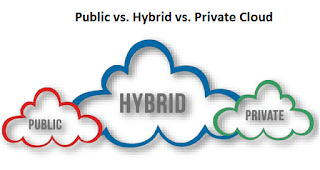Let us understand cloud deployment approaches.Once you decide to shift some of your applications into the cloud,the next decision you have to make is how to deploy.
There are three ways to deploy and integrate cloud services into your application architectures and infrastructure:
Public Cloud :The first and most common approach is the public cloud. In the public cloud, all the cloud resources, such as servers and disks, are owned and managed by the cloud provider, and access is delivered over the internet.
Physical hardware is shared with other organizations, and your view is virtualized. Your data is secure and isolated, but the cloud provider decides where it is stored and where your logic runs. The primary advantage to this approach is cost. You pay for what you use. You scale on demand based on your needs, and there is no need to purchase or maintain expensive hardware.
Private Cloud : The second most commonly used approach is the private cloud. This is where computing resources are used exclusively by one business or organization. It can be physically located on-premise or managed by a cloud provider. Private clouds allow for more security and control. This might be necessary for legal compliance. For example, government agencies or financial institutions may have more stringent storage requirements
for data that necessitates a private cloud.
Hybrid Cloud : Finally, we have a mixture of the two in the form of a hybrid cloud. That means some of your applications and data are running on your own private infrastructure,
and some are running on the public cloud. This model can be used in a variety of ways.
First, it can be used as a migration approach to transition your apps and services out of your private data center into cloud more gradually. This allows for better testing and easier migration.
It can also be used for segmenting work. You can connect the two environments together
with a secure, private network, in order to pass data back and forth. Part of the data is processed in your private, local infrastructure, and part of it is processed in the cloud.
And finally, the hybrid cloud can be used for cloud bursting.
You can push work up to the cloud when your internal data center hits a maximum workload.
At that point, you scale and burst up workloads to leverage Cloud, then drop back down to internal resources when the load returns to normal.
No matter what your organization's needs are, you can be confident that between the public cloud, private cloud, and hybrid cloud, there's a cloud deployment option that's right for you.


No comments:
Post a Comment